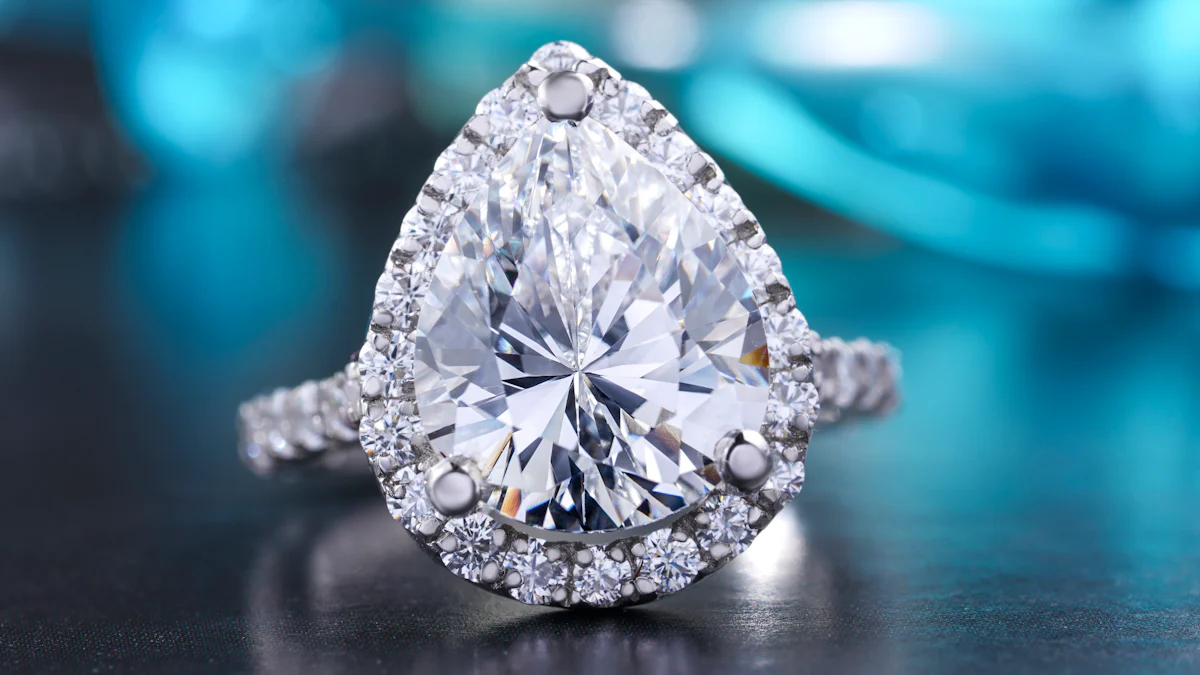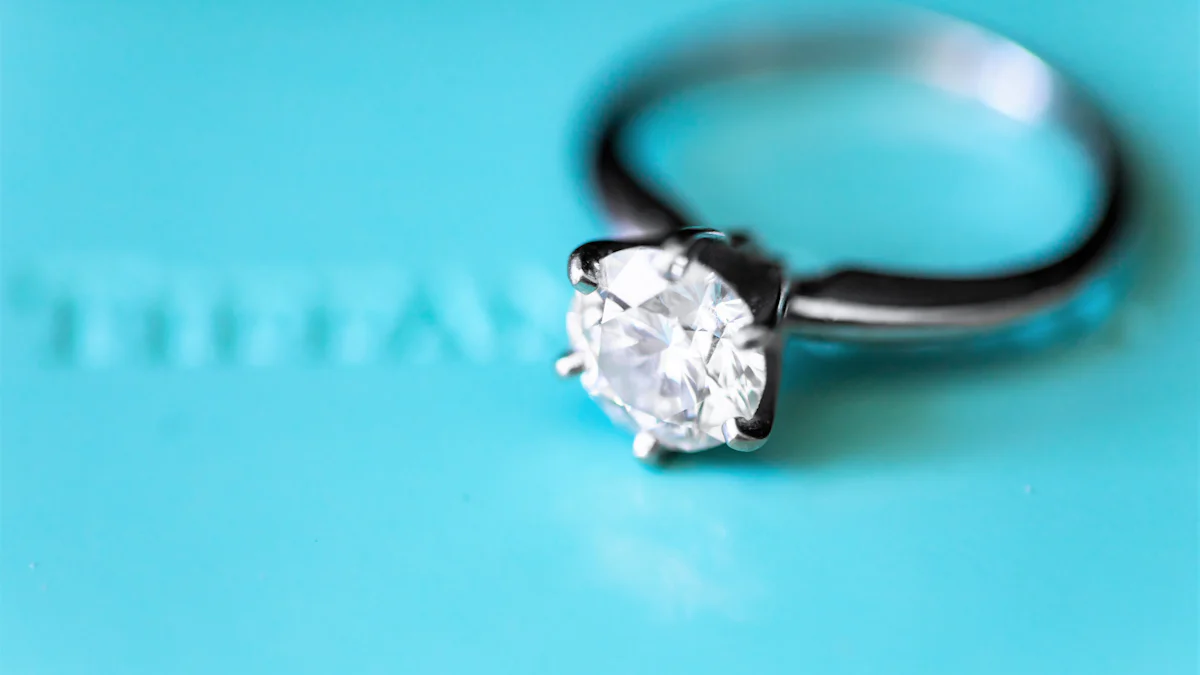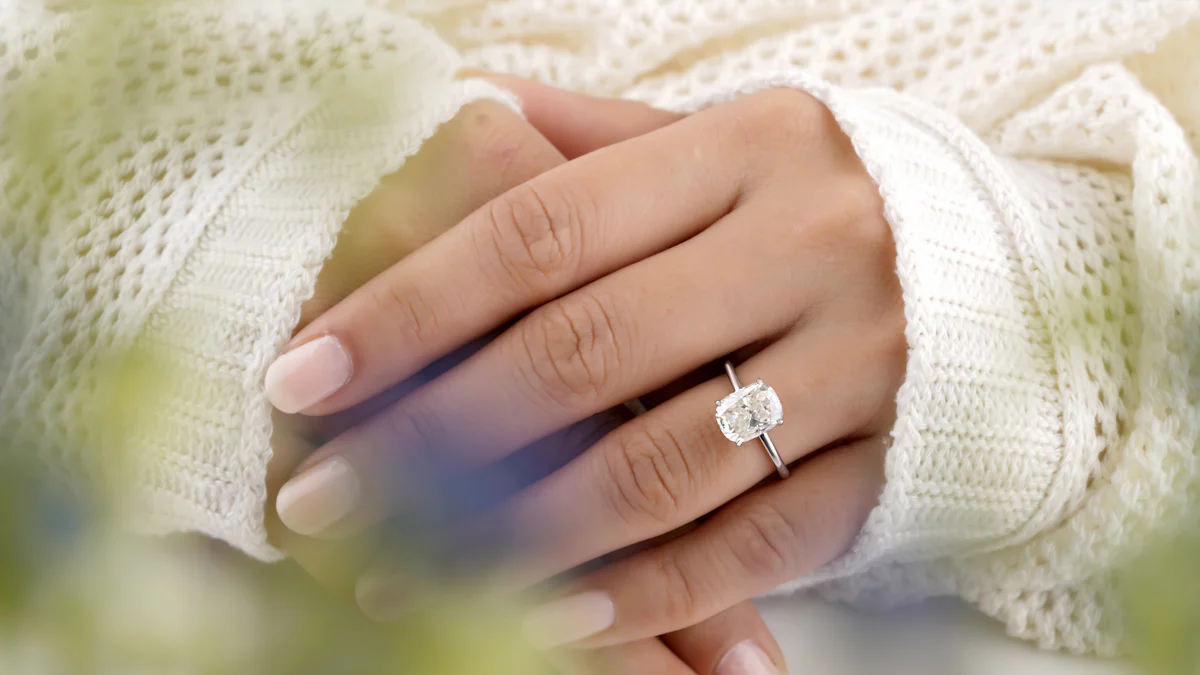1 ct. t.w. diamond meaning explained simply

When you see "1 ct. t.w. diamond meaning" on diamond jewelry, it refers to the total carat weight of all the diamonds in the piece. This means the combined weight of multiple diamonds, not a single stone. Understanding this term helps you make informed decisions when shopping for diamonds. Carat weight plays a key role in determining a diamond's value, so knowing what "1 ct. t.w." truly represents ensures you get the quality and size you expect.
What does 1 ct. t.w. mean in diamonds?

Understanding the term "1 ct. t.w." is essential when shopping for diamond jewelry. It provides clarity about the combined weight of all diamonds in a piece, helping you make informed decisions.
Breaking down the term "1 ct. t.w."
What does "ct." stand for?
The abbreviation "ct." stands for carat, which is the standard unit of measurement for a diamond's weight. One carat equals 200 milligrams or 0.2 grams. Carat weight directly impacts a diamond's size and value. Larger diamonds typically cost more because they are rarer and more desirable. However, in the context of "1 ct. t.w.," the carat weight refers to the total weight of all diamonds in the jewelry, not just one stone.
What does "t.w." stand for?
The term "t.w." means total weight. When paired with "ct.," it signifies the combined carat weight of all diamonds in a piece of jewelry. For example, a ring labeled as "1 ct. t.w." contains diamonds whose total carat weight adds up to one carat. This distinction is crucial because it tells you the weight of all the stones together, not the weight of an individual diamond.
How 1 ct. t.w. applies to diamond jewelry
Examples of 1 ct. t.w. in different types of jewelry
You will often see "1 ct. t.w." used to describe jewelry with multiple diamonds. For instance:
- Diamond Rings: A ring with several small diamonds arranged in a cluster or halo design may have a total carat weight of 1 ct. t.w.
- Earrings: A pair of diamond studs labeled as "1 ct. t.w." means the combined weight of both earrings equals one carat.
- Bracelets and Necklaces: Tennis bracelets or pendants with multiple diamonds often use this term to indicate the total carat weight of all the stones.
This labeling helps you understand the overall size and weight of the diamonds in the piece.
Why 1 ct. t.w. doesn’t mean a single 1-carat diamond
A common misconception is that "1 ct. t.w." refers to a single diamond weighing one carat. In reality, it represents the combined weight of all diamonds in the jewelry. For example, a ring with ten small diamonds, each weighing 0.1 carats, would have a total carat weight of 1 ct. t.w. This distinction matters because smaller diamonds grouped together may not have the same visual impact or value as a single 1-carat diamond.
When you see "1 ct. t.w.," always consider the number and size of the diamonds. Multiple smaller stones may create a dazzling effect, but they differ in appearance and value compared to a single larger diamond. Knowing this helps you evaluate whether the piece meets your expectations in terms of size, sparkle, and price.
Understanding total carat weight (CTW), cttw, and TW
When shopping for diamond jewelry, you often encounter terms like CTW, cttw, and TW. These terms describe the combined weight of all diamonds in a piece. Understanding their differences ensures you make informed decisions.
What is total carat weight (CTW)?
Total carat weight (CTW) refers to the combined weight of all diamonds in a jewelry piece. Jewelers use this term to describe the overall size of the diamonds, not just a single stone.
How CTW is calculated in diamond jewelry
Jewelers calculate CTW by adding the carat weight of each diamond in the piece. For example, if a ring has five diamonds, each weighing 0.2 carats, the total carat weight equals 1.0 CTW. This method provides a clear picture of the total weight of all diamonds in the jewelry.
Why CTW and cttw are interchangeable terms
CTW and cttw mean the same thing. Both represent the total carat weight of all diamonds in a piece. Some jewelers prefer one term over the other, but they convey identical information. Whether you see CTW or cttw, you can trust that it refers to the combined weight of the diamonds.
What is TW (Total Weight)?
TW, or Total Weight, expands beyond diamonds. It includes the combined weight of all gemstones in a jewelry piece, not just diamonds.
How TW differs from CTW and cttw
While CTW and cttw focus solely on diamonds, TW accounts for all stones in the jewelry. For instance, a ring with diamonds and emeralds will list its TW to include both types of gemstones. This distinction helps you understand the total weight of the piece, not just the diamonds.
Why TW can include other gemstones, not just diamonds
TW provides a broader measurement. It includes diamonds, sapphires, rubies, or any other gemstones in the jewelry. If you’re buying a piece with multiple types of stones, TW gives you a complete picture of its total weight.
Key differences between CTW, cttw, and TW
Understanding the differences between these terms helps you evaluate jewelry more effectively.
How these terms affect the description of jewelry
CTW and cttw describe the total weight of all diamonds, while TW includes other gemstones. If you’re focused on diamonds, pay attention to CTW or cttw. For pieces with mixed stones, TW offers a more comprehensive description.
Why understanding these differences is crucial for buyers
Knowing these terms prevents confusion. A piece labeled with TW might include non-diamond stones, which could affect its value. By understanding CTW, cttw, and TW, you ensure the jewelry matches your expectations in terms of diamond size and overall composition.
Common misconceptions about 1 ct. t.w., CTW, and TW
Misconception 1: 1 ct. t.w. means a single diamond.
Many people assume that "1 ct. t.w." refers to a single diamond weighing one carat. This belief often leads to disappointment when the jewelry contains multiple smaller diamonds instead of one large stone. The term "1 ct. t.w." actually represents the total carat weight of all diamonds in the piece. For example, a ring with ten diamonds, each weighing 0.1 carats, would have a total carat weight of 1 ct. t.w.
This distinction matters because smaller diamonds grouped together may not have the same visual impact or value as a single diamond of the same weight. A single 1-carat diamond is rarer and often more expensive than multiple smaller stones adding up to 1 carat. Always check the number and size of the diamonds in the jewelry to ensure it meets your expectations.
"A ring described as having a 1-carat center stone with 0.5 CTW means the center stone weighs 1 carat, and the total weight, including side or accent diamonds, is 1.5 carats."
Understanding this difference helps you avoid confusion and ensures you know exactly what you're purchasing.
Misconception 2: CTW and TW always refer to diamonds.
Another common misunderstanding is that terms like CTW, CTTW, and TW exclusively apply to diamonds. While CTW and CTTW specifically measure the total carat weight of diamonds, TW (Total Weight) includes all gemstones in the jewelry. For instance, a bracelet with diamonds and sapphires will list its TW to reflect the combined weight of both types of stones.
This distinction becomes important when evaluating mixed-stone jewelry. If you're focused on diamonds, pay attention to CTW or CTTW. TW, on the other hand, provides a broader measurement that includes other gemstones. Knowing this difference ensures you accurately assess the composition and value of the piece.
"Whiteflash offers an engagement ring featuring a 1-carat center diamond surrounded by smaller accent diamonds with a total weight of 0.5 carats, resulting in a CTTW of 1.5 carats."
By understanding these terms, you can better interpret jewelry descriptions and make informed decisions.
Misconception 3: Higher total carat weight always means better quality.
Many buyers believe that a higher total carat weight guarantees better quality. This is not always true. While carat weight influences a diamond's size, other factors like cut, color, clarity, and setting play a significant role in determining its overall value and appearance. For example, a poorly cut diamond with a high carat weight may lack brilliance, while a smaller, well-cut diamond can sparkle beautifully.
When evaluating jewelry, consider the quality of each diamond, not just the total carat weight. A piece with a 1 ct. t.w. label might include several low-quality diamonds, which could affect its visual appeal and value. Always ask about the cut, color, and clarity of the diamonds to ensure you're getting the best quality for your budget.
"To estimate the value of a 1 CT TW diamond piece, we consider not only the combined carat weight but also the cut, color, clarity, and setting of the diamonds involved."
By focusing on quality over quantity, you can choose jewelry that truly stands out.
Practical tips for buying diamond jewelry

When purchasing diamond jewelry, understanding key details ensures you make a confident and informed decision. Here are practical tips to guide you through the process.
How to verify the total carat weight of diamonds in a piece
Verifying the total carat weight of a ring or any other jewelry piece is essential. Jewelers calculate the carat total weight by summing up the carat weight of each diamond in the design. For example, if a ring has five diamonds, each weighing 0.2 carats, the total carat weight equals 1.0 cttw. Always ask the jeweler to confirm this calculation.
Inspect the jewelry closely. Look for labels or certificates that specify the cttw. These documents often detail the weight of the center stone separately from the smaller accent stones. If the piece includes multiple diamonds, ensure the combined weight matches the stated cttw. This step helps you avoid misunderstandings about the size and value of the diamonds.
Pro Tip: Use a jeweler’s loupe or magnifying glass to examine the diamonds. This tool allows you to see the size and arrangement of each stone, ensuring the total weight aligns with the description.
Questions to ask jewelers about ct. t.w., CTW, and TW
Asking the right questions helps you clarify the details of your purchase. Here are some key questions to consider:
- What is the weight of the center stone? This question ensures you understand how much of the cttw comes from the main diamond versus smaller stones.
- Does the total weight include non-diamond gemstones? If the piece features other stones, the total weight may not reflect only diamonds.
- Are the diamonds natural or lab-grown? This distinction can affect the value and appearance of the jewelry.
- What is the quality of the diamonds? Ask about the cut, color, and clarity of each stone. These factors influence the overall brilliance and worth of the piece.
By asking these questions, you gain a clearer picture of what you’re buying. This knowledge helps you assess whether the jewelry meets your expectations.
Why total carat weight is just one factor in determining value
While carat weight plays a significant role in pricing, it’s not the sole factor. The quality of the diamonds matters just as much. A poorly cut diamond with a high carat weight may lack sparkle, while a smaller, well-cut diamond can shine brilliantly. Always evaluate the cut, color, and clarity alongside the cttw.
The weight of the center stone also impacts the jewelry’s value. A single large diamond often holds more value than several smaller ones with the same combined weight. For instance, a 1-carat center diamond typically costs more than ten 0.1-carat diamonds, even if both add up to 1.0 cttw. This difference arises because larger diamonds are rarer and more desirable.
Remember: Total carat weight gives you an idea of the size, but quality determines the beauty and worth of the piece. Balance these factors to find jewelry that fits your preferences and budget.
By focusing on these practical tips, you can confidently navigate the diamond-buying process. Understanding cttw, the weight of the center stone, and the importance of quality ensures you make a purchase you’ll cherish for years.
Understanding the 1 ct. t.w. diamond meaning empowers you to make smarter jewelry purchases. By knowing how terms like CTW and TW describe the total weight of diamonds or gemstones, you can better evaluate the value and quality of a piece. Always ask questions and verify details with jewelers to ensure the jewelry meets your expectations. Research thoroughly before buying to avoid confusion and make informed decisions. This knowledge helps you choose pieces that align with your preferences and budget, ensuring satisfaction with your purchase.
FAQ
What does "1 ct. t.w." mean?
"1 ct. t.w." stands for 1 carat total weight. It represents the combined weight of all diamonds in a piece of jewelry. For example, a ring labeled as "1 ct. t.w." may feature multiple smaller diamonds that add up to one carat in total. This term helps you understand the overall weight of the diamonds, not the size of an individual stone.
Tip: Always ask your jeweler about the number and size of the diamonds to ensure the piece meets your expectations.
Does "1 ct. t.w." mean there’s a single 1-carat diamond?
No, "1 ct. t.w." does not mean a single diamond weighs one carat. It refers to the total weight of all diamonds in the jewelry. For instance, a bracelet with ten diamonds, each weighing 0.1 carats, would have a total weight of 1 ct. t.w. This distinction is important when evaluating the piece's appearance and value.
What is the difference between CTW, CTTW, and TW?
- CTW (Carat Total Weight) and CTTW (Carat Total Weight) are interchangeable terms. Both describe the combined weight of all diamonds in a piece of jewelry.
- TW (Total Weight) includes the weight of all gemstones, not just diamonds. For example, a ring with diamonds and sapphires will list its TW to reflect the combined weight of both types of stones.
Understanding these terms ensures you know whether the weight refers exclusively to diamonds or includes other gemstones.
How is total carat weight (CTW) calculated?
Jewelers calculate CTW by adding the carat weight of each diamond in the piece. For example, if a necklace has five diamonds, each weighing 0.2 carats, the total carat weight equals 1.0 CTW. This calculation provides a clear picture of the combined weight of all diamonds in the jewelry.
Does "t.w." include non-diamond gemstones?
No, "t.w." specifically refers to the total weight of diamonds in the jewelry. However, TW (Total Weight) can include other gemstones like rubies, emeralds, or sapphires. If you're buying a piece with mixed stones, check whether the label specifies "CTW" or "TW" to understand what the weight includes.
Are lab-grown diamonds included in CTW?
Yes, lab-grown diamonds are included in CTW calculations. Whether the diamonds are natural or lab-created, the total carat weight reflects their combined weight. Always ask your jeweler if the diamonds are natural or lab-grown, as this can affect the value and price of the jewelry.
Does CTW measure the weight of the metal in the jewelry?
No, CTW only measures the total weight of diamonds in the piece. The weight of the metal, such as gold or platinum, is measured separately in troy ounces. If you're curious about the metal's weight or purity, ask your jeweler for details.
Why is a single 1-carat diamond more expensive than multiple smaller diamonds totaling 1 ct. t.w.?
A single 1-carat diamond is rarer and more desirable than several smaller diamonds adding up to the same weight. Larger diamonds often have a greater visual impact and higher value. Multiple smaller diamonds may create a dazzling effect, but they typically cost less due to their abundance.
Does higher total carat weight mean better quality?
Not necessarily. While carat weight affects size, other factors like cut, color, and clarity determine a diamond's quality. A poorly cut diamond with a high carat weight may lack brilliance, while a smaller, well-cut diamond can sparkle beautifully. Always evaluate all aspects of the diamond, not just its weight.
How can I verify the total carat weight of a jewelry piece?
You can verify the total carat weight by asking for a certificate or documentation from the jeweler. This should detail the weight of the center stone and any additional diamonds. Use a jeweler’s loupe to inspect the stones and ensure the total weight matches the description. If in doubt, ask the jeweler to explain how the CTW was calculated.
Pro Tip: Always purchase from reputable jewelers who provide transparent information about their pieces.
See Also
The Importance of Three Stone Diamond Rings Explained
What Size Does a 2.25 Carat Diamond Really Have
Why a Gold Three Diamond Ring Stands Out

